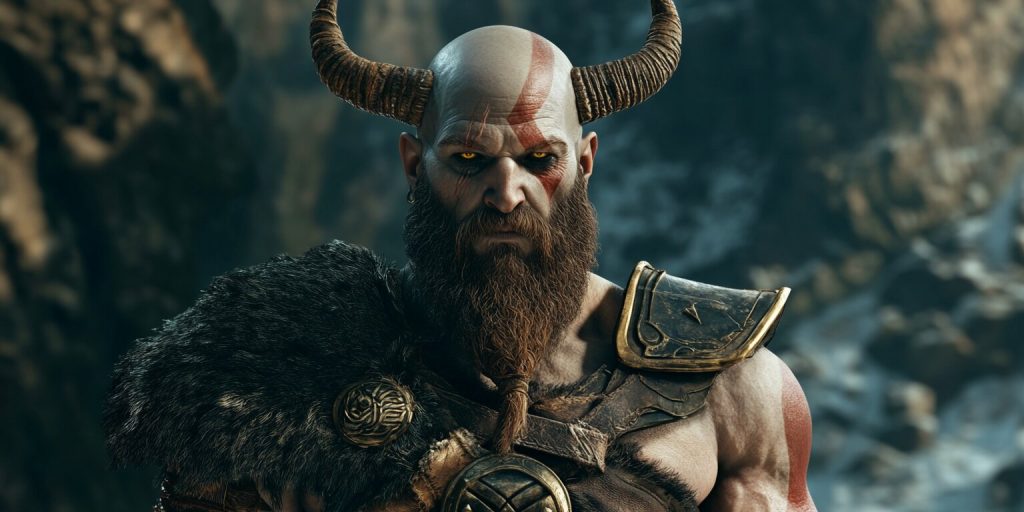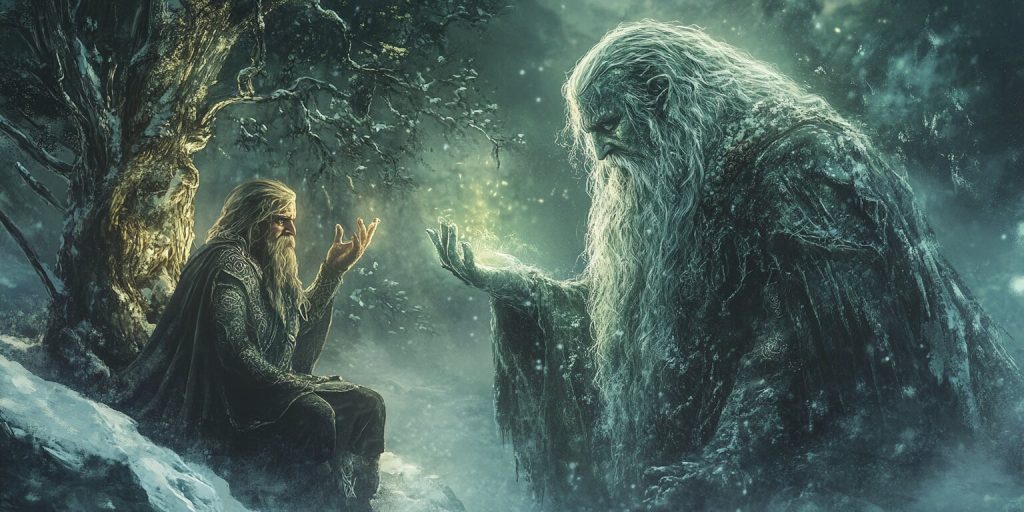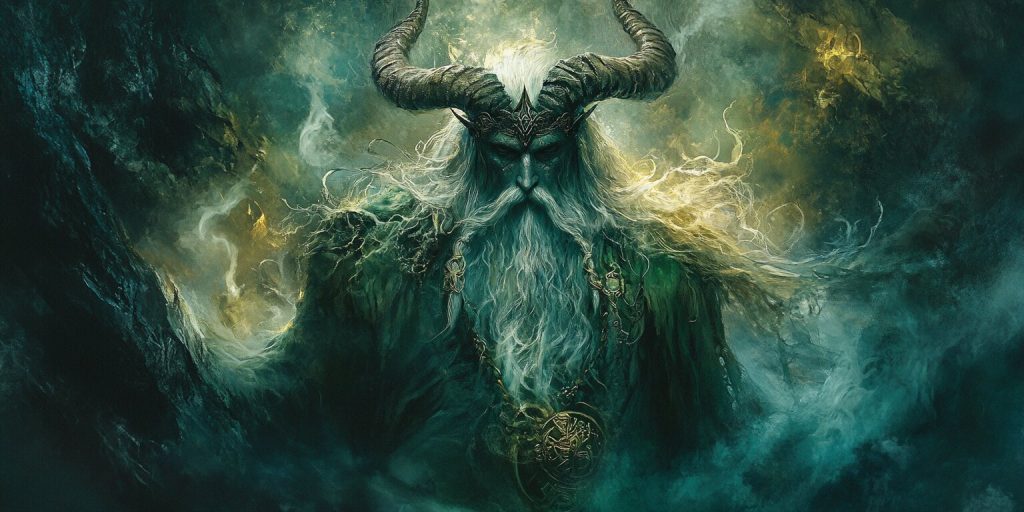Aesir Gods, Mimir, Norse Gods, Norse Mythology, Odin, Ragnarok, Vanir Gods
Why Does Mimir Have Horns?
Mimir is a key Norse mythology figure known for his deep wisdom and knowledge. He is often shown with horns, which makes us wonder why Mimir has horns. To understand this, we look at The Prose Edda and scholarly studies of ancient stories.
Mimir’s story and his role in the Æsir-Vanir War give us clues. He is known for his foresight and prophecy, traits that are essential to the unfolding story in God of War Ragnarok. Mimir’s horns show his link to power and knowledge. Research in comparative mythology shows horns symbolize wisdom and divine insight across cultures. This fits well with Mimir’s important role in Norse stories.
Let’s explore the deeper meanings of Mimir’s horns. We’ll look at ancient myths and how they affect us today, answering a common question – what mythology is Mimir from?
The Origins of Mimir Norse Myth
Mimir’s story is part of Norse mythology. It shows him as a god of great wisdom, akin to Odin’s maternal uncle. He is an Aesir god, also known as Mirmir god, standing out among others. Even Odin, the top Aesir god, valued his advice highly.
Mímir’s story connects with the famous Æsir-Vanir War. This war shows how gods fought and formed alliances.
Mimir’s Role in the Æsir-Vanir War
The Æsir-Vanir War was a big event in Norse stories. It was between the Aesir and Vanir gods. Mímir was key in this war.
He was sent to the Vanir as a hostage, but they didn’t trust him. They beheaded him. Yet, his wisdom lived on. Odin kept his head alive with magic so Mímir could still offer advice.
Mimir’s Wisdom and Knowledge
Mimir is known for his unmatched wisdom. Old stories and the Poetic Edda say he knew a lot. Odin, the war god, often asked for his advice.
Medieval scholars like Snorri Sturluson studied Old Norse tales. They showed how important Mímir’s wisdom was to the gods. It was key in big mythological events.
The Symbolism of Horns in Mythology
In ancient times, horns were seen as symbols of great meaning. They stood for things like divinity, wisdom, and power. This is true across many cultures, showing how important horns were in their beliefs.
In Norse myths, characters like Thor and the Valkyries wore horns. Horns symbolized strength and protection, making them a powerful symbol.
During ragnarök, a big event in Norse stories, horns were key. They showed big changes and battles between gods. This shows horns’ role in keeping the world balanced.
Studies on shamanic traditions show horns’ deep meaning. Shamans wore horned masks to connect with the divine. This shows horns as a way to gain wisdom and power.
Many ancient stories mention horned gods. In Celtic myths, Cernunnos was a horned god of fertility. In Greek myths, Pan was a wild god with horns. These gods were linked to nature and our wild side.
The Vanir gods in Norse myths were peaceful but still had horns, which shows that horns can mean many things in mythology.
Looking at art helps us understand horns better. Artists used horns to add deep meanings to their work, helping us see how ancient people saw and valued these symbols.
Why Does Mimir Have Horns?
Mimir mythology is shown in modern times, especially in the God of War series. He is seen as a wise and mysterious figure. His horns show his deep knowledge and his unique nature.

Modern Interpretations in Popular Culture
Fans discuss Mimir’s modern look in the God of War series. The game’s creators thought a lot before giving Mimir horns. They wanted to show his deep knowledge and role as a story guide.
Significance in God of War
In God of War and its sequel, Mimir’s horns mean more than looks. They show his deep wisdom, which plays a crucial role in the narrative of God of War Ragnarok. Mimir gives Kratos and Atreus important advice on their journey.
Reviews and discussions show how Mimir’s design adds to the game. It makes the story more engaging and connects old myths with new action-adventure video games.
Odin and Mimir: A Complex Relationship
In Norse mythology, the bond between Odin and Mimir is deep and full of meaning. Odin greatly values Mimir, as seen in the story where he carries Mimir’s head. This shows how much Odin looked up to Mimir for advice and wisdom.
Mimir’s Head as a Talisman
The story of Odin getting Mimir’s head is a key part of Norse myths, found in The Prose Edda. After Mimir died, Odin kept his head alive with magic and spells, making Mimir’s head a powerful tool for Odin.
It linked the world of the living with the world of the dead. Odin could then get deep knowledge from Mimir’s head. This shows how Odin valued knowledge and the bond between life and death.
Odin’s Search for Knowledge
Odin always wanted to know more, so he bonded closely with Mimir. Odin knew he needed all the knowledge he could get to stop Ragnarok, the end of the world.

By talking to Mimir’s head, Odin gained deep insights and could see the future. This shows how far Odin went for wisdom and how important knowledge was to him in his mission.
Mimir’s Representation in Modern Media
Mimir is now a big name in modern media, especially video games. He mixes old Norse myths with new art and stories, making him very popular worldwide, especially among fans of PlayStation titles.
Character Design in Video Games
In games like God of War Ragnarök, Mimir’s appearance combines old and new. He has horns like in the myths but looks fresh and new. The team ensured his look honors his mythic roots but also feels new.
The makers of Mimir focused on every little detail, making him stand out in the game and improving the story. His voice and face animations show his deep wisdom and mystery, adding to the game’s story.
Cultural Impact and Reception
Mimir’s role in God of War Ragnarök has made a big splash. Fans and critics love the game and Mimir’s part, which has made Norse myths more popular in today’s media.
People all over the internet talk about Mimir. They share art and theories about him, including insights into how Sindri and Brok contribute to the narrative. This shows how much fans love Mimir and how he affects modern stories.
Conclusion
Mimir is a key figure in Old Norse mythology, known for his deep wisdom. His horns symbolize his knowledge and high status among the gods. His background and bond with Odin explain his big role in stories like Ragnarök.
Many stories, from the Edda to scholarly views, show how much people like Mimir. His horns mean strength and knowledge, showing old beliefs and new views. Mimir’s wisdom guides us through stories from the Æsir-Vanir war to the tree Yggdrasil.
Today, Norse mythology is popular again, thanks to games like God of War Ragnarök. These games show Mimir’s big impact on culture. His stories and wisdom will continue to inspire people, making his image a lasting symbol in stories old and new.

